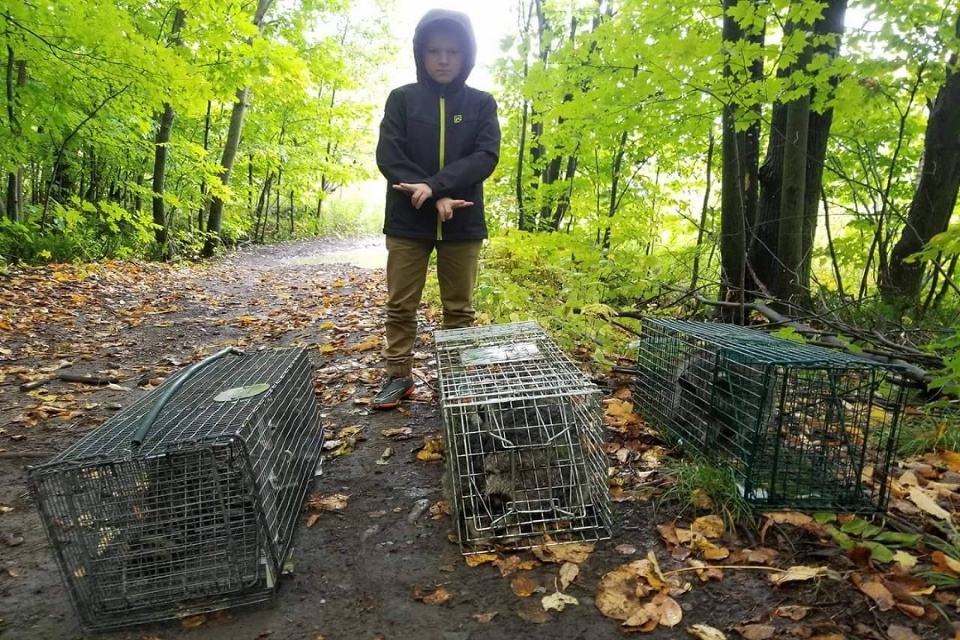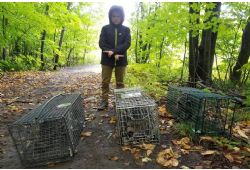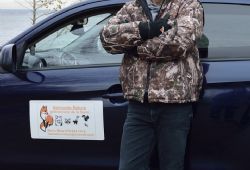Ever since he was a young child, Mario Blais was fascinated by animals. As a hunter-trapper from Trois-Rivières, he recalls many fond memories of getting up close and personal with wild animals, learning about their habits and their fear of humans. He captured or killed his prey legally and safely, drawing upon his experience and expertise.
The Legend of JimmyWhile hunting one morning, Blais crossed paths with a wolf cub who was not old enough to be left on its own. He discovered that the mother had been killed. It was at this precise moment that Blais’s passion for hunting transformed into an unconditional love for all animals. Not knowing exactly what to do with the orphan wolf cub, Blais took him home to try to bottle feed him. He did this day and night for two weeks, until the frail cub was able to drink and eat on his own. Blais’s nephew Jimmy had recently been born, so he named the cub Jimmy, after his sister’s son.Blais says that this period in time offered him the best experience of his life with a wild animal. “With this wolf, there was a connection that I had never experienced before with other animals. It was like I was his father; the leader of the pack. I would bring him to the forest everyday so he could stretch his legs. It was so beautiful to see him run and jump freely,” says Blais. “During one of those walks on a bright sunny day, I lay down on the forest ground while Jimmy was running about discovering the forest. I fell asleep, but about an hour later I awoke and to my surprise, Jimmy was sleeping on me! That’s when I knew we were really forming a wolf pack.”Because the law doesn’t allow for citizens to keep wild animals in captivity, Blais had no choice but to make arrangements for Jimmy to live at a zoo.Changing Directions
The sadness and confusion Blais witnessed in orphan Jimmy’s eyes would forever change how he thought about animals. From that moment forward, Blais dedicated all his time to supporting wild animals found in urban or remote areas who are injured or orphaned due to hunting. As a result, he founded Harmonie Nature. Though his ultimate goal would be to open his own refuge to care for and rehabilitate wild animals, his current mission is clear: save as many animals as possible. “I don’t gain economically from this work,” says Blais. “I do it out of love for the animals.”A Trapper with Heart
In the years that followed, Blais drew upon his knowledge of how cities deal with unwanted wild animals that find their way onto citizens’ properties. Though most cities aren’t viable habitats for wild animals, some small mammals will still attempt to move in. While you might not be too surprised to find a squirrel, a mouse or a rat in your neighbourhood, you wouldn’t want to find yourself face to face with a beaver, skunk, deer, fox, coyote, black bear, lynx, marten or bat! “Humans have built their homes on land that was once a natural wildlife habitat,” says Blais. “We shouldn’t be too shocked at the end of the summer season, when food is scarce in mountainous areas, that wildlife make their way into cities to look for food. The smallest wildlife can easily find shelter, safety and food.”In an ideal world, we would be living in harmony with urban wildlife. That said, certain species can carry transmissible diseases to humans such as rabies. That’s why they shouldn’t be touched or moved by a non-professional wildlife trapper. “Tolerance is still the best solution if the damage caused by small wildlife is minimal. What’s more, the animals could just be passing through temporarily, unless you purposely contribute to its presence,” says Blais.On their website, the Ministère des Forêts, de la Faune et des Parcs indicates that both city and household garbage cans give wildlife the perfect place to stop for a bite to eat all year long. Cat or dog food placed outside of your home is very attractive to small wildlife such as beavers, skunks and squirrels. If your dog or cat is enjoying the food, you can be sure that wildlife will too! The space under your patio platform, shed or garage is also enticing to wildlife who may choose to hide out for the winter or give birth to their young. Attics are often a safe hiding spot for certain animals who might even try to chew through electrical wiring.Prevention & Education
Having been a hunter himself, Blais is very familiar with black bears who are targets twice a year during hunting seasons. It’s illegal to hunt a mother bear who is accompanied by one or more cubs. Offenders face a hefty fine and could even receive jail time. Sometimes, when the cubs are young and vulnerable, the mother bear might leave them alone momentarily to get food. Hunters can be confused when they see the mother bear alone; even experienced and attentive hunters might struggle to determine if the bear is male or female.Because education is often the best solution, an obligatory training for hunting black bears would be more than necessary. It would allow hunters to deepen their knowledge and learn to use appropriate tools to determine whether a bear is male or female. Unfortunately, a number of mother bears are also killed by vehicles on roads that run parallel to their territory. Thankfully, many orphan bear cubs are lovingly rescued and cared for by Blais and his network.The Human Pack
When a wild animal in danger is reported by a shelter, municipality, business or citizen, Blais jumps in his truck and makes his way over to support whatever species might be waiting for him. Article 67 of la Loi sur la conservation et la mise en valeur de la faune stipulates that you cannot kill or capture an animal causing damage on your property if you can first prevent it by removing its burrow or food source. That’s where Blais comes in.Rather than capture the animal in a cruel fashion or relocate it to an area where its chances of survival are slim, Blais is called upon for his expertise on a variety of species as well as his network of shelters, volunteers and zoos, who all have their own expertise in saving and rehabilitating wildlife. Blais has contacts in all four corners of the province.“When I see the love and attention given to each of the animals from Jacques and Rachel at Centre-Refuge Nynous in Sainte-Béatrix, it’s so beautiful it makes me cry,” says Blais. “When I see animals that survived thanks to our intervention, I know we’ve accomplished our mission.”Harmonie Nature also works with organizations such as the SPCA, Le Nichoir, Clinique des oiseaux de proie, the Ministère des Forêts, de la Faune et des Parcs and many others.Expansion
Seeing the demand for wildlife shelters increase over the years, Blais harbours the dream of opening his own shelter one day. Like many of the partners in his network, he relies on public donations and revenue from wildlife interventions across the province in order to keep Harmonie Nature operating. Thanks to his network and the interest, passion and determination of dozens of volunteers, he believes his project will come to fruition.For more information or to donate to this wildlife cause, visit Harmonie Nature on Facebook as well as online at centre-refuge-nymous.com.

 In The Latest Issue:
In The Latest Issue:



 BY:
BY: 

Tweet
Share